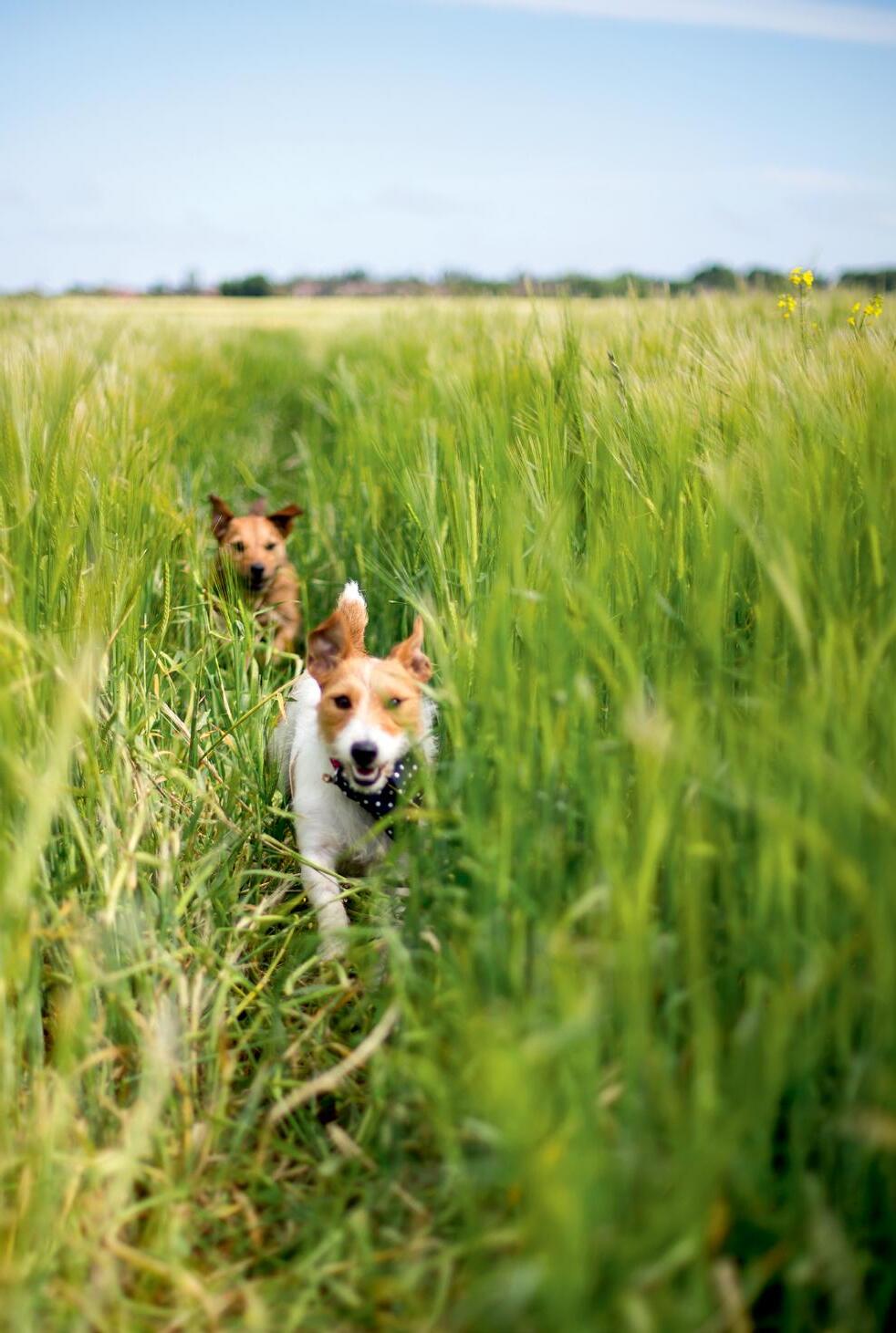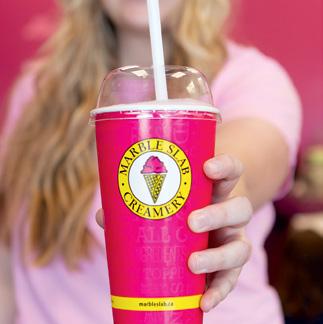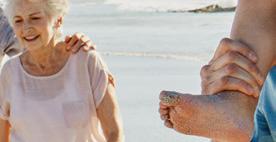CAA MAGAZINE
• Road trips, lakeside dips and outdoor tips
• St. John’s and Saint-Pierre and Miquelon
• Festivals, music and farm-to-table treats
SUMMER 2023
YOUR GUIDE TO SUMMER FUN
GET OUTSIDE AND ENJOY CANADA WITH CAA


• Road trips, lakeside dips and outdoor tips
• St. John’s and Saint-Pierre and Miquelon
• Festivals, music and farm-to-table treats
GET OUTSIDE AND ENJOY CANADA WITH CAA

There’s nothing gloomy about rainy days. That is, when you have WeatherTech FloorLiners. Laser measured for your specific vehicle, the WeatherTech FloorLiner is guaranteed to provide a perfect fit and the ultimate carpet protection, for as long as you own your vehicle. So when Mother Nature is at her worst, don’t worry because we’re at our best.


A MESSAGE FROM CAA CONTRIBUTORS MEMBER LETTERS ON THE RADAR
Travel, arts, culture, local hot spots and more
THE WIRED WANDERER
Stay connected when you’re far from home
By Jen MalliaTHWARTING CAR THEFT New technologies promise high-tech security
By Jeremy FreedTHE GOOD PLACE: SPARKING LIGHT
Darkspark brought its blend of music and social justice to communities across Canada. Now, it’s going global
By Kate RaeDRIVEN BY GOOD: GROWING MINDS
This high-school teacher from Alberta is cultivating a love for agriculture far beyond the classroom
By Sean DeasyTESTING THE WATERS
Meet the volunteers protecting our lakes, rivers and streams
By Jenn Smith NelsonTHE TRUTH ABOUT EVs
Setting the record straight about common electric-vehicle myths
By Matt BubbersA LONG LOOK AT NEW ZEALAND New Zealand’s diverse landscapes and natural attractions make it the perfect place to linger
By Truc Nguyen26
A PIECE OF THE ROCK
How to combine a visit to Newfoundland’s capital city and a trip to France in one holiday
By Valerie HowesSUMMER ADVENTURE GUIDE
Packing lists, timely tips, and how to use your CAA Membership to have a summer to remember. Plus, helpful resources, road safety pointers and exclusive benefits












AT CAA, WE ARE OBSESSED about the safety of our Members and go to great lengths to rescue them when they are stranded on the roadside, as well as to protect them in their homes and vehicles or when they are travelling. Now, we’ve extended that protection to the Internet.
In our ever-connected digital world, computer systems and the data they contain have become common targets for cybercriminals. Ranging from phishing emails that attempt to harvest your personal data, to destructive malware that makes its way to your computer, these increasing risks jeopardize our online security. And it is sometimes challenging to keep up with the latest threats and required safety precautions.
Staying protected online starts with education and knowledge. By keeping current with the online risks, we are then able to take measures to protect our data and online activity. To this end, we have added another new benefit to CAA membership—one that provides our Members with the latest information about the different cybersecurity threats and methods to protect their computer and data from the increasing risks posed by cybercriminals. This new benefit is called cyberconIQ® and every Member has this service built into their CAA Membership.
I encourage you to use this benefit to gain a deeper understanding of the new and growing threats to cybersecurity. There are a multitude of ways to protect ourselves online, and most can be easily adopted from settings that are already built into the devices and websites we use. It all starts with education, and I hope this benefit helps you strengthen your online security and safeguard your data. On behalf of every caring CAA Associate, I wish you and your family safety in all your travels, including those in cyberspace. CAA
Jay Woo President and CEO CAA Club Group of Companies

































Truc Nguyen is a communications professional and a freelance style and travel writer for many publications, including Elle Canada, CBC Life, and The Globe and Mail. Previously, she was a senior editor at Flare and an associate editor at American Vogue Living. When she’s not hunting for truffles in Oregon or chasing the northern lights in the Yukon, Nguyen lives in Toronto with her family.
Turn to page 20 to read all about Nguyen’s latest travels to New Zealand.
Jack Daly is a Glasgow-based illustrator, artist and graphic designer who was born on the bonnie banks of Loch Lomond, in southern Scotland. Formerly a successful brand designer, Daly has shifted careers and is now a full-time freelance illustrator. His impressive body of work spans the spectrum—from editorial to advertising and design packaging—as does his client roster, which includes The New York Times, BMW and pop singer/songwriter Adele.
Get a good look at how Daly illustrates common electric-vehicle myths on page 34.

Editor Dick Snyder
Executive Art Director Lionel Bebbington
CAA Editor Jacqueline Kovacs
Copy Chief Dali Castro
Managing Editor Emily Rivas
Senior Editors Karen Eull, Jen Mallia
Editorial Assistant Alexis Ramlall
ART
Senior Designer Lauren Livingston
Junior Designer Zoë Rod
PRODUCTION
Production Manager Kim Latreille
FINALLY CONTENT
President Eric Schneider
Creative Director Abi Slone


Account Director Tobiasz Woroniecki

Vice President, Media Sales Laura Maurice laura.maurice@finallycontent.com
National Account Manager Dana Francoz dana.francoz@finallycontent.com
Account Manager Rachelle Vaughan rachelle.vaughan@finallycontent.com
CONTRIBUTORS
Jenn Smith Nelson is a multi-award-winning freelance travel writer, photographer and author based in Saskatchewan. She has been published in four countries and in four languages, contributing hundreds of articles to numerous outlets, such as enRoute, The Globe and Mail, Toronto Star, explore and Canadian Geographic. Nelson often writes about connecting with nature, wildlife, family and adventure travel.
On page 30, Nelson showcases the volunteer lake stewards who are protecting our great Canadian lakes, rivers and streams.
Karen Bliss, Lola Augustine Brown, Jason van Bruggen, Matt Bubbers, Jack Daly, Sean Deasy, Daniel Ehrenworth, Jason Franson, Jeremy Freed, Lisa Gordon, Stephen Alexander Harris, Yuki Hayashi, Vawn Himmelsbach, Beth Hitchcock, Val Howes, Sam Island, Cailynn Klingbeil, Claudia Laroye, Jenn Smith Nelson, Truc Nguyen, Kate Rae, Tracey Tong, Vivan Vassos, Damien Weighill
FOR CAA MEMBERSHIP INFORMATION OR TO CHANGE YOUR MAILING ADDRESS: EMAIL membership@caasco.ca TELEPHONE 1-800-268-3750 MAIL SISG Department
60 Commerce Valley Drive E., Thornhill, ON L3T 7P9. CAA Magazine is created and published quarterly by Finally Content Inc., on behalf of CAA. All product specifications and prices were correct at press time. Merchandise shown is subject to availability while quantities last. The publishers cannot accept responsibility for the safe arrival of unsolicited manuscripts, transparencies or illustrations, but letters are welcome. Printing: TC Transcontinental. All rights reserved. Reproduction in whole or part is prohibited without prior written permission from the publisher. To place an ad in CAA Magazine, please contact sales@finallycontent.com. Publications Mail Agreement Number 40065459. Return undeliverable Canadian addresses to: P.O. Box 8802, STN Main, Concord, ON L5K 0P1. CAA does not necessarily share the editorial opinions expressed in CAA Magazine, and third-party advertised products or services are not necessarily endorsed by CAA. ® CAA trademarks owned by, and use is authorized by, the Canadian Automobile Association. ®/™ CAA trademarks are owned by, and use is authorized by, the Canadian Automobile Association. Driven by Good™ is a registered trademark of CAA Club Group. ® TripTik and TourBook trademarks are the property of, and use is granted by, the American Automobile Association. Any advice is intended to provide general information only. CAA does not accept liability for damage or injury resulting from reliance on the information. Trademarks and registered trademarks are property of their respective owners. Partners and/or offers are subject to change without notice.


I must let you know how pleased I am with the new magazine style. I love short, informative articles that get to the point, but I even found myself being interested in the longer articles, too. This was the first time that I read almost the entire magazine. Kudos to everyone who decided on this new format! Thank you for all your hard work.
—Carole AndrewsI enjoyed a marvellous time exploring Newfoundland on a CAA Travel vacation this past summer. The itinerary was awesome and the tour guide was very knowledgeable and fun to be with. I will definitely take more tours with CAA Travel.
 —Susan Dudas
—Susan Dudas
Have a story or comment you’d like to share? Email us at caamagazine@caasco.ca and you could be featured in an upcoming issue. Letters may be edited for length and clarity.
I love the magazine as I have always found good, practical information in it. I just received the latest issue and discovered the size of type is much smaller than in the past, which makes it difficult for old people to read it. This is an observation I hope you will take into consideration.
—Linda DeJongheWe have indeed heard from CAA Members concerned about readability and we have taken steps to address this, including bumping up the type size. Please let us know what you think.
—CAA
MagazineI am enjoying reading through the spring issue of CAA Magazine, but I feel I need to point out an error in the article on roundabouts on page 49. The article states that the first roundabout in Canada was built in Montreal in 1998. I moved from Ottawa to Edmonton in 1977 and roundabouts were common there. I don’t know when they started building them, but it might be worth an article. I went back there for a visit last summer and they’ve actually removed a few, but there are still many traffic roundabouts throughout Edmonton at many major intersections.
—Simon BlakeWe clearly missed the mark on a few facts in this article—and we heard about it! Definitions of roundabouts, rotaries and traffic circles vary widely, so it’s difficult to corroborate hard data on their inception dates and even how many were installed across the country. We apologize for the oversight in the piece (and the accompanying image) and will do better next time.
—CAA
MagazineI have enjoyed the benefits of my CAA membership as well as the magazine for about eight years. I live in Sault Ste. Marie and the article about my home city on page 37 of the spring issue caught my attention. I just want to point out a few errors. Silver Creek Golf Course is only 18 holes. It is not family run (it’s run by Garden River First Nation), nor does it have 200 campsites connected to the course. As for the Water Tower Inn, nothing is far from downtown in Sault Ste. Marie, but the Water Tower would not be considered within the downtown limits. I thought I should point these out, and I look forward to each issue of the magazine.
—Mr. L. BottosWe are always working to improve accuracy, so we appreciate your feedback. We apologize for these oversights, which occurred due to errors in our fact-checking process. We take this very seriously and have taken steps to improve and ensure accuracy in future issues.
—CAA
MagazineThis was the first time that I read almost the entire magazine
 PHOTOGRAPHY: (THIS PAGE, FROM TOP TO BOTTOM) ISTOCK/RAWPIXEL LTD; COURTESEY OF BIKA FARM
PHOTOGRAPHY: (THIS PAGE, FROM TOP TO BOTTOM) ISTOCK/RAWPIXEL LTD; COURTESEY OF BIKA FARM
WHEN
dining alfresco this summer, think outside the patio and go further afield, literally, with unique experiences that are as local as can be. These farms offer seasonal fare just a fork’s throw from where it is grown and nurtured.

At Mabel Hill Farm Kitchen & Marketplace, in Nipawin, Sask., diners can sit on a covered veranda overlooking the vast gardens and orchards, or gather inside the modern-rustic farmhouse. Before heading home, check out the marketplace for takehome treats like fresh herbs and produce, meat pies and artisanal preserves.
One of the most coveted reservations in the Ontario countryside, Eigensinn Farm is the passion project of pioneering farm-to-table chef Michael Stadtländer. For the epic eight-course dinner, almost every
ingredient—from maple syrup and honey to fowl and livestock—is sourced from the 100-acre property.
At Prairie Berry Farm, a Métis-owned business in Glenlea, Man., farmers Jennifer and Matthieu Turenne team up with Indigenous and local chefs for two weeks each summer to create a seasonal berry-themed menu. These juicy, multi-course dinners are served in gazebos in their strawberry patch.
The FireWorks Feast at chef Michael Smith’s Inn at Bay Fortune, near Souris, is PEI’s hottest ticket.
After touring the farm, guests indulge in a spectacular meal of delicacies foraged, organically grown or procured locally. And that includes unlimited fresh oysters to start.
At Bika Farm, just outside of Montreal, the cuisine has
These farms offer seasonal fare just a fork’s throw from where it is grown and nurtured
Chef Fisun Ercan, owner of Bika Farm, tends the vegetable garden that inspires her summer menu.

WHEN MARIA LOCKER WAS still a young mother of two, she recognized that her community of Milton, Ont., lacked a viable networking group for women, so she created one.

There wasn’t a safe space to connect with like-minded peers, she says. “To bounce ideas off someone with experience is so crucial and can be a catalyst to success for women who may otherwise feel isolated and alone.”
Locker founded RevolutionHER in 2010. What started as a digital platform where women could share ideas evolved into a multi-faceted media collective, with a magazine, podcast, mentorship program and an educational learning portal that offers resources and video classes. They also host events featuring international thought leaders like Dolly Parton and New York Times bestselling author Dr. Shefali Tsabary. Locker has now seen her vision impact more than 60,000 women in 30 countries and counting.
Inspired by her parents, who juggled family and business for 45 years, Locker has learned that balancing both is unrealistic at times. It’s better to prepare for ebbs and flows.
“My support networks provide a steady foundation for me to flow with what comes, and so far, it has worked pretty well.”
–Vivian VassosNominate a localer. Do you know someone who goes above and beyond to make the world a better place? We’d love to hear about them. Send nominations to drivenbygood@caasco.ca and they could be our featured Localer in an upcoming issue.

This spacious, stylish cooler will keep drinks chilled when you’re on the go, no matter where summer takes you.
• non-skid raised feet ensure stability
•extreme ice retention so food and drinks stay cold for days
Prepping for a backyard party? Visit shopwithcaa.com to check out the Pelican cooler.

From the streets of Tel Aviv to Toronto’s Yorkville neighbourhood, Miznon (miznon.com)—which also has locations in Paris, Singapore and New York—is serving up a fresh take on seasonal Mediterranean food. You’ll understand what the buzz is about when you bite into pillowy pitas stuffed with tahini, pickles, spicy peppers, and beef or chicken. Stock your fridge with a serving of chef Eyal Shani’s selfproclaimed “best hummus you will ever eat!” Be strategic—it sells out quickly.
–Beth HitchcockBefore letting dogs run free, take them through these training tips. A good run provides exercise and mental stimulation for your dog, but before removing that leash, you want to be sure Buddy will come back when called.
Proper recall training is essential to prevent dogs from wandering onto a road or getting lost. Melissa Millett, head dog-training instructor at In Dogs We Trust in London, Ont., shares recall training tips for pups (or any dog who needs a summer refresher).
The first step, she says, is teaching Buddy to focus. Reward him each time he makes eye contact without prompting while on a leashed walk.
Next, practise restrained recall in a fenced area. Have someone hold the dog while you move a few metres away. Call him by name and say, “Come,” as your helper releases the lead. Always reward him for coming—even if it takes a while.
Still don’t trust your pup’s recall skills? Don’t force it. Of Millett’s nine professionally trained dogs, she only allows six off leash. “One is a terrier with a high prey drive, another is only two pounds and could be a snack for a bird of prey, another is a deaf car-chaser,” she says. “Many dogs are happy with hikes on long leashes and enjoy running in fenced yards.” –Tracey
 Tong
Tong
Stock up
chef Eyal Shani’s selfproclaimed ‘best hummus you will ever eat!’PHOTOGRAPHY: (THIS PAGE, FROM TOP TO BOTTOM) ISTOCK/SOLSTOCK; DANIEL NEUHAUS
Six spectacular bike rides for a summer day
From towering mountains to dramatic coastlines, Canada offers so much to see on two wheels. Here are six scenic rides to do in a day (with plenty of time to stop for pictures).
Confederation Trail, PEI
Spanning 273 kilometres, this old railway line, now a popular hiking/ biking trail, runs through the centre of the island. The easternmost section, from Morell to Elmira, is a moderate day ride with the best views of the coastline, past fishing villages and scenic St. Peters Bay.
54 km one way
Pelee Island Waterfront Trail, Ontario
A 90-minute ferry trip from Leamington or Kingsville drops riders off at the trailhead by the Pelee Island dock. Family-friendly trails fringe the largest island on Lake Erie, past beaches, nature reserves and Ontario’s oldest wine region (now Pelee Island Vineyards).

30 km loop
Niagara River Recreation Trail, Ontario

This paved path beside the Niagara River zips right past the roiling waters of the falls and into historic downtown Niagara Falls with its many cafés and attractions, including one of North America’s largest Victorian rose gardens—a fragrant spot for a breather.
56 km one way
Riding Mountain National Park, Manitoba
A ride through grasslands, forests and many lakes leads to the resort townsite of Wasagaming. This national park boasts nearly 370 kilometres of trails with bike routes that vary from easy to rugged climbs. The Strathclair Trail is a moderate option with a gentle downhill grade.


23 km one way
Meewasin Trail, Saskatchewan
This lengthy 105-kilometre trail lives up to its name—meewasin is nêhiyawêwin (Cree) for “It is beautiful.” Start at the Remai Modern and wind along the banks of the South Saskatchewan River—past shopping and cafés—to Wanuskewin Heritage Park.

16.5 km one way
Bow Valley Parkway, Alberta
This road route features stunning mountain views through Banff National Park, ending at the turquoise waters of Lake Louise. A pilot program, running in June and September, will limit vehicle use on the parkway, making this unforgettable trip even better for road cyclists.

48 km one way
– Cailynn Klingbeil
CAA gears up to help when your bike breaks down. Your CAA membership includes CAA Bike Assist®, which is roadside assistance for your bicycle. If you run into a problem that can’t be fixed on the spot, CAA will transport you and your bicycle to wherever you need to go. Visit caasco.com/bikeassist to learn more.
I Mother Earth’s frontman, Edwin, drives a lot. Commuting from his home outside of Toronto, the rock singer clocked an impressive 666,666 kilometres on his last vehicle, a Porsche Cayenne, “and then it died 38 kilometres later,” he reports. That’s a lot of time for road tunes. Says Edwin, who will be performing with I Mother Earth at Burlington’s Sound of Music Festival this summer, “I mostly like songs with groove when I’m driving.”
–Karen Bliss
Crazy Seal
Freedom!
George Michael
Bloody Well Right
Supertramp
Elevation
U2

Blinding Lights
The Weeknd
Tom Sawyer Rush
Superstition
Stevie Wonder
Somebody to Love
In Your Eyes
Peter Gabriel
Queen Chaise Longue
Wet Leg
WHETHER YOU’RE ON TWO WHEELS, or four, it’s everyone’s responsibility to follow the rules of the road. More often than not, cyclists and drivers end up on the same roads where tension—and collisions—may occur.
Here’s how to be well equipped for a safe bike ride:

Helmets To ensure the right fit, follow the 2-V-1 rule. The helmet rim should sit two finger widths above the eyebrows. Ensure the straps form a V under the ears. One finger should fit between the chin and chin strap.
Bells Bicycles need a working bell or horn to alert other cyclists when you’re approaching or attempting to pass. But don’t assume a bell is loud enough to alert cars of your presence.
Lights All bikes must be illuminated for rides at night and on rainy or foggy days. Attach a white light to the handlebars or the front of the frame and add a red rear light and reflector.
Clothing Wear proper running or cycling shoes, along with fitted pants that won’t get caught in the chain. Consider adding reflective tape to clothes, helmet and bike.
Jump in the car and fire up the GPS. Your destination: one of the many lively music, art, food and cultural festivals being staged across the country this summer. There’s fun for everyone, whether you’re looking for something local or you’re ready for a road trip.
What’s that mouth-watering aroma wafting across Toronto’s Woodbine Park? It’s the Toronto Food Truck Festival and those mobile kitchens are serving up sizzling snacks (think dumplings, tacos and fritters) from August 4 to 7.
Here’s something for crustacean lovers to dig their claws into. The PEI International Shellfish Festival is celebrating its 25th anniversary, September 14 to 17, at Charlottetown’s Event Grounds. Load up on lobster rolls or watch the shucking championship to learn best-in-show techniques.
Creativity prevails at the Manitoba Electronic Music Exhibition, June 8 to 10, with innovative workshops and performances by cutting-edge local musicians and artists.
Regina’s Victoria Park comes alive with free daytime concerts on four stages—plus a designated children’s area, vendors’ market and beer garden—during Regina Folk Festival, August 11 to 13.
When it comes to summer fun, there’s more to Alberta than the legendary Calgary Stampede. The Grande Prairie Night Market Festival (June 23 to 25, July 14 to 16, August 11 to 13 this year) is an all-ages celebration of community and diversity through food and crafts, plus live performances.
And finally, stroll through picturesque Queen’s Royal Park in Niagara-on-the-Lake and take in the juried show of more than 80 artists and artisans at Artistry by the Lake on the first three days of July.
–Beth HitchcockStay safe. Visit caasco.com/cycling to learn more.
To ensure your helmet fits properly, follow the 2-V-1 ruleGear up to ensure you’re seen, heard and protected when cycling.


As a combination of the Italian words for “foot” and “hill”, Piedmont is a region encapsulated in beauty. Situated between Switzerland and France, surrounded by the Alps, it has a reputation for many things. Wine, food and culture are three such luxuries, as well as its natural and regional parks and reserves.
The cities, Alessandria, Asti and Biella, all brim with art and events, and though Piedmont isn’t surrounded by sea, its abundance of lakes, wetlands and network of rivers gives it a lush landscape. But, above all that, what’s particularly memorable about Piedmont is its hamlets, of which the region has been named home to 17 of the most beautiful in Italy.
Vogogna is one such hamlet. Located in the Verbano area, between Lake Maggiore and Lake Ort, its narrow streets, stone houses and wooden balconies all serve in transporting visitors to another time and place. It’s particularly wellknown for its Vogogna Castle, built in the 14th century by Giovanni Visconti, bishop of Novara and Lord of Milan.
Orta San Giulio, in the province of Novara, is another that sits by the lakes. One main draw of the location is the Sacro Monte di Orta, a complex of 20 chapels that run along a specific
route. The buildings are filled with sculptures and paintings, surrounded by Lake Orta.
Venture closer to the coast, toward Genoa, and you’ll discover Monforte d’Alba. Though another hamlet steeped in Medieval history, its surrounding vineyards boast a legacy of growing Barolo wine. For those who love its taste, the hamlet is an ideal fusion of sipping and sightseeing.
If food is more your preference, Cocconato is a scenic spot home to only 1,600 people and is famous for its Robiola cheese. With a unique microclimate, its countryside also has olive and palm trees, as well as all sorts of wildlife.
In the Alps, you have Garessio, a hamlet in Cuneo, full of high-altitude trails that traverse the mountain and a ski station overlooking the Gulf of Liguria. Venture farther north and you’ll find Usseaux in Val Chisone. It’s known as the “Hamlet of Murals”, thanks to the various artwork depicting past life in the village.
Rosazza, located northeast of Turin, has a reputation for being a place of mystery. With only 100 people living there, it’s tiny, but where it lacks in population it makes up for in atmosphere with a castle that dates back as far as 1883, surrounded by houses decorated with Masonic and Occult details.
Wherever you choose to explore in Piedmont, you can rest assured you’ll return home satisfied, with new tastes, sights or experiences. But above all, you’ll return with lasting memories and a newfound appreciation for Italy.
With its deep valleys and rich history, there are plenty of reasons to visit the Italian region of Piedmont
DOES THE THOUGHT of travelling and losing your tech connection (or getting hacked!) terrify you? Here’s how to protect yourself online when you’re on a trip, whether for work or for a vacation.

High roaming charges can take the shine off an otherwise productive work trip or a relaxing vacation. Canada’s wireless rates are among the highest in the world, according to a survey conducted earlier this year by Rewheel, a telecom research company based in Helsinki.
Make it easy on yourself by investing in a dual-SIM phone, such as the Samsung Galaxy S22+ or the Apple iPhone 13 Pro Max. Then pick up a SIM card at your destination, which allows you to use your phone via a local number and service provider, as well as check your home number in Canada for messages by toggling between the two SIMs. You can even forego roaming charges altogether by relying on apps like Signal and WhatsApp to make calls and send text messages.
More than 70,000 cyber-crime incidents were reported to police in 2021, according to Statistics Canada. But there are ways to stay cyber-safe. When you use your devices at an Internet cafe or via a shared Wi-Fi network, always assume that your data is not secure. Consider a virtual private network (VPN) service to encrypt your information and identity when you go online. You
can also set a location that is different from where you are. This avoids restrictions based on geography, involving sites that let you log in only from your home province.
You can also learn ways to protect yourself further, via cyberconIQ® (caasco.com/cybersecurity-education), which provides personalized cyber-security lessons, free of charge, to CAA Members.
Make sure your devices have enough battery power when you arrive at your destination, so you can access your reservations, maps and travel documents. Take advantage of power ports on the plane or at the airport. And for convenience and peace of mind, purchase a portable power bank like the Skross® Reload 6.
A cable lock or lockable bag offers a low-tech but smart way to fend off thieves. Consider the Metrosafe™ LS200 ECONYL® Anti-Theft Crossbody Bag by Pacsafe®, with its cut-resistant and RFID-blocking materials—ideal for safely stashing tablets and headphones, as well as travel documents and currency.
Keep these tips in mind, whether you’re travelling for work, you’ve opted for a digitally nomadic lifestyle or, perhaps, you just want to stay connected while away for the weekend. Speak to a CAA Travel Consultant when planning your next trip. Or stop by for a visit— many of our locations carry essential travel gadgets and gear. CAA
CAA has your tech accessories! Visit shopwithcaa.com for a selection of road-tested gadgets to help keep all your devices working while you’re in transit.









AS ANYONE who has recently driven a new vehicle knows, our cars and trucks now come loaded with a variety of hightech features to make driving easier and safer. Despite these advances, however, even the smartest of modern vehicles is still a target for car thieves. Rates of theft are on the rise—and significantly so in urban areas like Toronto and Montreal.
As the internal systems of cars become increasingly sophisticated, so too have the methods of thieves to evade them. Common theft techniques now include easily available electronic devices to “clone” nearby key fobs, allowing thieves to enter a vehicle and drive off with it in a matter of minutes. Cars are then either sold for parts or loaded onto shipping containers for export overseas, making them next to impossible to recover. (Tip: Keep your keys in a Faraday Bag, which blocks radio signals so thieves can’t intercept them.)
While no vehicle is theft-proof, some automakers offer enhanced systems for added security. Honda’s stolen-vehicle locator—HondaLink™, offered by subscription on newer models—uses GPS
technology to assist authorities in finding stolen cars. GM’s OnStar system can remotely slow down a stolen vehicle to hamper a thief’s getaway. Other add-ons, like BMW’s Drive Recorder and Tesla’s Sentry Mode, turn a vehicle’s cameras into a surveillance system that can capture thieves in the act.
Automakers are also responding to high-tech thievery in more direct ways, notes Sam Abuelsamid, a mobility analyst at consulting firm Guidehouse Insights. “What we’re starting to see now is something known as ultra-wideband [UWB] technology,” he says. By using a complex and precise system of communication between the fob and the car, UWB is more difficult to fool than previous generations of remote fobs, he explains. “It identifies you and authenticates where you are before it’ll unlock the door and start the car, so it’s a much more secure system.”
Other security features Canadians can expect in the coming years are biometric scanners like the ones found on smartphones. “I think biometrics is probably going to be the next big thing that we
see roll out more broadly,” Abuelsamid predicts, noting that the technology is already available in the Genesis GV70 SUV, which uses a fingerprint reader to identify authorized drivers.
Despite these advances, our cars’ reliance on wireless networks invites opportunities for thieves to hack them. “The more points of connectivity you have, the more potential there is for bad actors to get in and do anything, from stealing your data to disabling your car with a ransomware attack,” Abuelsamid says. The auto industry is aware of these weaknesses, he says, and manufacturers are taking action.

For now, police suggest focusing on visual deterrents. Even with high-tech protection, it’s still a good idea to do whatever it takes to discourage thieves.
“I would suggest making the vehicle less tempting to thieves,” says Ryan Peterson, manager of automotive services for the CAA Club Group, “meaning, parking under a light or in a secured garage. Thieves want the lowest risk with the highest payoff.” CAA
PROTECT YOUR VEHICLE. Shop online at shopwithcaa.com or visit a CAA Store to see our range of products, including car-key signal blockers.
With its diversity of dramatic landscapes and natural attractions, New Zealand’s North Island is a place made for lingering
By Truc NguyenThis page: Wai-O-Tapu Thermal Wonderland, with its vividly coloured pools, is just a short drive from Rotorua; opposite page: Auckland, New Zealand's largest city, offers culture, shopping and fine dining—with beaches, rainforests and wineries nearby.

IT TAKES ME MERE MINUTES to fall hard for Waiheke Island. I'm sitting in the white sand at Onetangi Beach, amid dazzling turquoise waters, vivid red and purple wildflowers and boldly painted food trucks serving up smash burgers and fresh ceviche. But it takes me much longer to experience all that northern New Zealand has to offer.
Some destinations are simply too special to rush through. I don't want to have to choose between restful beach days and exciting cultural experiences, both of which northern New Zealand boasts plenty. So, I've planned a leisurely long stay—a travel trend on the rise thanks to more flexible time-off plans and remote-work scenarios.
Long-stay vacations make it more worthwhile to travel great distances. After all, it’s not easy to make it to Aotearoa, or “land of the long white cloud,” as New Zealand is known in Māori. It takes more than 13 hours to fly directly to Auckland from Vancouver, and you might need a day or two to get over jet lag.

And although the North Island is relatively compact (it’s a little larger than the island of Newfoundland), its winding hilly roads can add to your driving time, and unpredictable weather can sidetrack even the best-laid plans.
Before traversing the North island, choose a home base. I recommend starting your journey in Auckland, the largest city in New Zealand and a hub for travellers. Rent a car and head south to the city of Rotorua and its numerous tourist attractions, then north to explore stunning subtropical beaches and fascinating historical sites.
The city’s corporate core has many hotels and apartments for rent, but you can also opt for a charming bungalow or spacious villa in the trendy suburbs of Ponsonby or Grey Lynn. Your urban forays must include the Auckland Art Gallery, shopping the flagship stores of New Zealand's best designers in Britomart and a sunset hike up Mount Eden. Spend evenings in the neighbourhood bars and restaurants near your rental. Ponsonby Central is a lively marketplace with more than 20 restaurants and bars to choose from. And you'll find Grey Lynn locals enjoying oysters and wine at Lilian.

Pick a sunny day to take the 40-minute ferry ride from downtown Auckland to picturesque Waiheke Island for glimpses of olive groves and vineyards, pristine white-sand beaches and brilliant blue waters around every bend. Reserve a Saturday morning for the famous Matakana Village Farmers’ Market, which is worth the hour-long drive north of the city, especially if you make time to visit Matakana Oysters and Sawmill Brewery.
One could easily spend a week or more sightseeing in and around Rotorua, which is almost three hours south of Auckland. Known for its geothermal activity and (sometimes strong) sulphur smell, this city also boasts world-class mountain biking trails. Get hands-on at a geothermal reserve and mud spa, go on a treetop walk in a redwood forest and watch a Māori cultural performance. From Rotorua, it’s an easy day trip to iconic tourist attractions, such as the Hobbiton movie set and the eerily lit Waitomo Glowworm Caves.


The Bay of Islands is a subtropical beach paradise in what's called the "winterless north" of New Zealand.

In the subtropical Northland region, about three hours north of Auckland, are beautiful orchards of persimmon, kiwifruit and mandarin trees—and more picture-perfect glorious beaches. Take a scenic hike through a forest of majestic kauri trees, past stunning waterfalls. Stop by the Waitangi Treaty Grounds, where the country’s Declaration of Independence was signed in 1835. Admission tickets are good for two consecutive days, so you can take in, at your own pace, the site’s heritage buildings and two museums to find out more about Māori history and culture. Stay a week or longer in each of these regions to explore the bounty of beaches and charming small towns. Sample local seafood and buy handmade souvenirs at the The Old Packhouse Market in Kerikeri. Or, visit the laid-back town of Russell and sip drinks at the historic Duke of Marlborough, New Zealand's oldest licenced hotel. Having enough time to visit a destination’s must-see attractions and stumbling upon under-the-radar local gems—that’s the best part of the long-stay vacation. CAA
• Canadian passport holders need an approved electronic visa waiver, called a New Zealand Electronic Travel Authority (NZeTA), to board their flight. Note that the application process can take more than 72 hours.
• Travellers planning to stay longer than three months must apply for a visitor visa, which takes at least 44 days to process.
• In New Zealand, travel insurance is required for some visa categories and is recommended for visitors using the NZeTA visa waiver.
• It's best to purchase travel insurance as soon as you book your tickets. CAA vacation package plans include full coverage to protect you from the costs of medical emergencies, trip cancellation and delays, as well as lost or damaged baggage. CAA offers single- and multi-trip plans to cover international or interprovincial travel.
Five favourite long-stay destinations

PORTUGAL One of Europe’s more affordable attractive destinations— sunny weather, wonderful beaches and lovely towns tiled with the worldrenowned azulejos—Portugal is popular with travellers who want to stretch their trip time and their budget.
SPAIN Chill on the beaches of Costa del Sol, sample wines in Rioja and relish a culinary adventure in Barcelona and San Sebastián.
NEW ORLEANS, LOUISIANA Stroll through historic neighbourhoods in the birthplace of jazz, including Tremé, the stately Garden District and the French Quarter where every night's a festival of music and spicy Creole food.
MALTA With its ancient history, stunning coastline and year-round balmy temperatures, this archipelago is a magnet for divers and boaters, as well as travellers interested in exploring the towering sea caverns of The Blue Grotto.
VICTORIA, B.C. Spend a few weeks in Canada’s Garden City. Start downtown with tea at the Empress, then slow down and enjoy the tranquility of the many surrounding ecological reserves. Ease into the West Coast lifestyle with a restorative forest bath in The Great Bear Rainforest.
We can help you get there.
A CAA Travel Consultant can work with you to plan and book your long-stay vacation. Call 1-844-370-9876 to learn more.
 By Valerie Howes
By Valerie Howes
ST JOHN’S is a delightful mix of contradictions and complements. It’s large enough to offer vibrant food and cultural scenes, yet small enough to explore by foot in a couple of hours. Between the colour-pop houses of Jellybean Row and the possibility of spotting icebergs, seals and spouting whales near coastal trails, this city had me hooked right from my first visit.
The streets of St. John’s are built at angles fit for ski slopes, and the weather gods cycle through every season most days, but nothing stops the locals from getting out and having fun. Live music festivals, wharf-fresh seafood and friendly banter at every turn keep visitors coming back year after year. For this trip, I’m eager for new experiences at rural spots just outside of the city and an excursion to Saint-Pierre and Miquelon—two pebbles on a rocky archipelago off the coast of Newfoundland.

One of the best ways to get to know a place is through its food. I start off by venturing down to dine bar-side at Terre, a restaurant that’s located conveniently (for me), in the lobby of the Alt Hotel, where I am staying.

Chef Matthew Swift, whose pedigree includes stints at Montreal’s Joe Beef and Le Vin Papillon, helms the kitchen and is committed to the wild, farmed and fished resources of the region. The herbs, garnishes and greens are as local as it gets—Swift grows them on the hotel deck in his greenhouse and garden.
To delve deeper into Newfoundland’s foodways, I take a 45-minute drive to Lori McCarthy’s woodland home in Mobile, on the Avalon Peninsula.
McCarthy is a forager, outdoors-woman, award-winning author and host of the culinary-adventure TV show The East Coast Forager. Her residencies, called Food Culture Place, get people rolling up their sleeves to try everything from pickling to butchery to campfire-making—with lots of stories and sampling along the way.
Shortly after my arrival, McCarthy hands me an antique teacup (her grandmother’s) to fill with an infusion of my
own choosing. Her Irish setter, Tessa, looks on as McCarthy and I chat while preparing a lunch spread of hearty beans, golden-topped cod cakes and warm baked goods with tart partridgeberry jam.
Next, I visit Petty Harbour—only 15 minutes away from St. John’s and the birthplace of award-winning musician Alan Doyle. These days, it’s home to Janet Harron, a craft-vinegar maker who gives heritage tours.
Harron strides through Petty Harbour in combat pants, her long silver hair flying from beneath a bucket hat, as she shares insider stories of community life. We take in the bridge that once divided Catholic and Protestant residents and the Fishing for Success building, where wooden boat and handline fishing traditions are kept alive. Our tour ends inside the Petty Harbour Fisherman’s Co-Operative Society building, where Janet makes her stout-fed vinegar. I sample the sharp and caramelly condiment, while looking at black-andwhite photos of local scenes, including cheeky kids cutting cod tongues at the fish plant for pocket money.
That evening, I have reservations at Portage, a new St. John’s restaurant opened by alumni from Raymonds, the recently shuttered fine-dining spot that put Newfoundland cuisine on the world map.


The Portage menu draws on the Asian culinary heritage of chef Celeste Mah, as well as the local sensibilities of Newfoundland-born-and-raised Ross Larkin, season six winner of Top Chef Canada. Here, the kelly green dining room is homey, the servers chatty and the dishes made for sharing.
On my last day in the city, I go shopping. At St. John’s Farmers’ Market, I browse stamped butter knives, cardamom-infused sugar cubes and colourful hand-stitched journals.
Later, I head downtown to Rosemill Antiques & Collectibles, on the recommendation of friends. “We sell everything here, from a baby’s fart to a clap of thunder,” says owner Rick Clarke.
While I didn’t find those, this place is full of treasures—just like the city itself.
STAY
Alt Hotel St. John’s 125 Water St. germainhotels.com/en/alt-hotel/st-johns
SHOP

St John’s Farmers’ Market 245 Freshwater Rd. sjfm.ca
EAT
Portage 128 Water St. portagenl.ca
Three days in Saint-Pierre and Miquelon

AFTER A 45-MINUTE FLIGHT from St. John’s (Canadians don’t need a passport, just valid photo ID), I arrive at my hotel in Saint-Pierre. Les Terrasses du Port SPM looks out to a bustling harbour—only this time, with French flags and names like Marcel and Marie painted on the boats. Saint-Pierre is the smaller of the two main islands in this self-governed, French-owned archipelago. It’s also the most urban—in the loosest sense of the word—with a population of about 5,300. Summer visitors to these islands include dolphins, orcas and puffins—as well as francophiles eager to spend their euros on fresh-baked croissants and stinky cheeses.
Saint-Pierre and Miquelon had its heyday during Prohibition, when islanders supplied booze from their “wet” French territory to be smuggled to the dry U.S.A. Today tourism and fishing are the main economic drivers. Keen to understand the history of this distinctive place, I start my visit at Le Musée de l’Arche.
My legs tremble as I stand by a guillotine as tall as an NBA star and listen to my guide recount the sole public execution in these parts. It was the first and last time a guillotine was used in North America.
I examine stone microblades, chiselled for skinning animals, as I read about the
Indigenous peoples who came to hunt, fish and gather here millennia ago. And I take in treasures recovered from some of the 600plus shipwrecks on record from the past 200 years—the North Atlantic doesn’t play around on stormy days.
Later that day, crossing lichen-covered rocks over treeless terrain, I’m able to put the history and culture of this place into its geographical context, thanks to my guide, Gilles Gloaguen, of Escapade Insulaire.
As I take in undulating landscapes carved by melting glaciers, Gloaguen points out a soaring trio of bald eagles. We pick wild cranberries as we hike and chat about the fishing grounds, the semi-wild horses that roam in herds, the challenges of farming on a rock, and the presence of white-tailed deer and snowshoe hares that were introduced for hunting.
To get a taste of local heritage crafts, I spend my final morning at Chez Rika Simon, a studio-boutique redolent of leather and sparkling with handcrafted necklaces and earrings. While Erika Simon tells me all about the elderly lady who was Saint-Pierre and Miquelon’s last fish-leather tanner, I pick out pieces of cod and calfskin for a craft project. Next, I learn to trace, cut and stitch the leather to create my own luggage tag.
Simon’s love of reviving traditional techniques and materials to make contemporary objects ties into a bigger dream for this young mother of two—keeping the distinctive local culture alive and relevant. When her kids run through the door at noon (the whole island stops for lunch en famille, French-style), I can’t help thinking they have the best of all worlds. CAA
Before heading out for a meal, make reservations as restaurants here tend to get fully booked. And they keep French hours—noon to 1:30 p.m., then, 7 p.m. onwards—so plan your day accordingly.
In the wood-panelled bistro Les P’tits Graviers, the crispy-edged beef entrecôte comes with pan-fried potatoes and melted-Roquefort dipping sauce so tasty I mopped up every last smear.
Le Feu de Braise serves the silkiest crème brûlée, whose torched top shatters satisfyingly at the tap of a spoon.
Meanwhile, perfect for a late breakfast, Roc Café offers up paper-thin buckwheat crepes filled with molten goat cheese, locally cured bacon and a sunny-side-up egg, then folded like origami.






Volunteer stewards work to protect our freshwater lakes, rivers and streams
By Jennifer Smith NelsonMany of us look at a lake in summer and see peace and inspiration—a place for boating, swimming or just a little bit of relaxation. For others, the relationship goes much deeper. When Max Abraham looks out across Saskatchewan’s Pike Lake, about 20 minutes south of Saskatoon, he sees home.
“You look at it a little differently when you live there,” he says. Abraham and his neighbours take pride in the habitat they share with walleye, pike, perch and other species. These folks recognize that their lake is a vital resource that sustains wildlife and provides food as well as opportunities for recreation—and they work hard to keep it that way.
Abraham, a retired school principal with a passion for the outdoors and the environment, does his part with the Pike Lake Cottage and Watershed Association. As a former president of the association, he has volunteered alongside his community to monitor water levels, rehabilitate the shoreline and raise funds for their initiatives. They also collaborate with the water security agency and scientific community to study the lake and participate in watershed
planning. All these projects rely on data, mostly collected by residents. “Almost everyone who lives out here has been a volunteer at some point,” he says.
Across Canada, volunteer stewards play an essential role in their communities. They dedicate time to ensure that the ecological health of lakes, rivers and waterways is preserved. They advocate, fundraise and do community outreach—or become citizen scientists monitoring algae bloom and invasive species, measuring levels and testing water quality.
“Volunteers can get out more often, and the assessment is easy to do and does not require a science background,” says Kerry Royer, community engagement specialist with Niagara Peninsula Conservation Authority. Citizen science apps such as iNaturalist and eBird are easy-to-use tools that help collect data.
Citizen scientists in the Niagara region use the Visual Assessment Survey Tool (VAST). This program was developed by Kiersten McCutcheon, coastal science

These folks recognize that their lake is a vital resource and they work hard to keep it that way
coordinator at Niagara Coastal, a nonprofit group that trains volunteers to collect data throughout the Great Lakes region. Volunteers snap photos of the shoreline, which helps researchers track changes. “The VAST program adds even more data, and the more data you have, the better,” notes Royer. Pictures are powerful tools—seeing is believing when it comes to education, advocacy and policy change.
Often, water-quality issues aren’t addressed until they reach a noticeable state. In September 2014, Mattatall Lake in northern Nova Scotia turned an abnormal pea-green colour due to blue-green algae bloom, and the local community took action. “Our lake was not very built up and we didn’t expect this,” recalls Donna Spracklin, who stepped up as volunteer president of the Mattatall Lake Stewardship Association. Prior to 2014, residents had noticed some green globs, but didn’t realize how quickly the toxic algae can spread. “We were naive and ignorant,” she says.
(Left) Volunteers attend a workshop hosted by Nova Scotia’s Mattatall Lake Stewardship Association.

(Below) Pike Lake, south of Saskatoon, is monitored by local residents committed to ecological health. (Opposite page) A citizen scientist photographs the shore of Lake Erie, at Morgan’s Point Conservation Area, as part of the Visual Assessment Survey Tool program.

Reduce the use of high-phosphorus fertilizers and detergents that can encourage the overgrowth of lake algae and aquatic plants.
Go slow when boating near the shoreline—the wake can cause erosion.
Don’t flush medications or chemicals down the toilet.
Preserve existing shoreline vegetation. It helps fend off erosion, filters water and prevents flooding.
Keep septic systems clean and sealed to prevent pathogens from seeping into groundwater.
Once aware of the severity of the issue, more than 50 residents rallied to raise funds for research, in conjunction with Dalhousie University and the Nova Scotia Department of Environment and Climate Change. The algae bloom eventually abated, but the community’s work has not. Residents continue to monitor water quality and educate themselves about aquatic plants and other species that share the lake. A volunteer collects data about the lake’s declining loon population and shares it with Birds Canada, the country’s national bird conservation organization. Floating platforms were built to support loon nests. Initial attempts were unsuccessful, but more elaborate platforms are in the works for this summer.
“We need to learn to live more within the natural environment to allow our native species to maintain their home there, too,” says Spracklin. “We need to share.”
With 20 percent of the world’s freshwater in our care, we also share a responsibility to sustain its health—one test tube at a time. CAA
✓ First walk-in tub available with a customizable shower
✓ Fixed rainfall shower head is adjustable for your height and pivots to offer a seated shower option






✓ High-quality tub complete with a comprehensive lifetime warranty on the entire tub
✓ Top-of-the-line installation and service, all included at one low, affordable price Now



















Darkspark brought their extraordinary blend of music, youth and social justice to remote communities across Canada. Now, the team is going global
By Kate RaeIN 2014, SINGER-SONGWRITER MEL LARKIN’S passion for self-expression and social change brought her across the bridge from her home in Prince Edward County, Ont. She had been invited into the community of Tyendinaga, just a short drive north, to help Mohawk youth tell the colonial history of Canada through songwriting. Her partner and fellow musician, D’Ari Lisle, built a mobile recording studio, and Darkspark was born.
The two were invited back year after year, and in 2017, Darkspark received a grant to replicate the experience—coined Four Directions—across the country, bringing a team of music producers, videographers and filmmakers to 15 remote and urban communities. It’s hard for Larkin to pick just one favourite song from that time. There’s the haunting Waiting for Change by youth in Attawapiskat First Nation, made especially heartbreaking, given the continued lack of resources and support allocated to that community. Then there’s Taught by the Best from Rankin Inlet, a joyful celebration of the wisdom passed down through the generations.

Darkspark accumulated more than 36 million impressions across their social media platforms, and Four Directions was recognized by Barack Obama and the United Nations Alliance of Civilizations. But then came 2020. “We were on the verge of having to shut the whole organization down,” Larkin recalls. Instead, the couple sat down and conceptualized their latest project, Versions, inspired by Lisle’s experiences as a firstgeneration Jamaican Canadian. “There is a Jamaican musical tradition called ‘versioning,’ where one producer creates a beat, and various artists record different songs on top of it,” says Larkin.
Versions offers a year-long fellowship for young Black, Indigenous and People of Colour (BIPOC) emerging artists. The selected fellows (chosen from 1,000 applicants from 51 countries) will spend a year writing, recording and releasing songs about their personal experience with racism. “In addition, they’re all conceptualizing and implementing a social impact project in their home communities,” notes Larkin. There will also be a global call-to-action at the end of the fellowship to encourage youth from around the world to submit their own songs on the topic of discrimination.
“We weren’t sure how we would be able to build a community in a virtual setting,” Larkin says. But the family vibe they’d been able to create with their earlier projects hasn’t been lost, she notes. “It’s all been pretty amazing.” CAA
Do you know of a Good Place? We want to celebrate community organizations that strive to make life better for all. Send nominations to drivenbygood@caasco.ca to share their stories.
Taught by the Best, from Rankin Inlet, is a joyful celebration of the wisdom passed down through the generations
AS WITH ANY NEW TECHNOLOGY, people tend to cling to misconceptions based on misinformation and popular myths— until they have the opportunity to experience it for themselves. Electrical vehicles are no exception. Drivers want to know how EVs stack up against traditional internal combustion engine (ICE) vehicles. We’re here to bust, confirm or qualify some of the common perceptions about EVs.

The bottom line: A typical EV will emit, over the course of its life, lower levels of greenhouse gases that impact climate change, compared with an equivalent ICE (gas-powered) vehicle. When considering life-cycle emissions—“cradle to grave” emissions from suppliers, along with manufacturing, logistics, driving and even tual recycling—Volvo found that its gas-powered XC40 emits 58 tonnes of carbon dioxide equivalents (CO2e), while the all-electric XC40 Recharge emits less, at 27–54 tonnes. The variation is due to the source of power going into electrical grids.
An EV charged by wind-generated electricity emits 73 percent less CO2e than its ICE counterpart over 200,000 kilometres. There is no data for Canada, but on Europe’s current electrical grid, the EV emits 25 percent less than its ICE counterpart. And, since Canada’s grid is less carbon-intensive on average than Europe’s, an EV would be an even cleaner choice here.

Of course, that doesn’t mean you’re doing the planet any favours if you replace a fuel-sipping Toyota Prius hybrid with a Hummer
Yes, the manufacture of EV batteries is a carbon-intensive process. According to a report by Volvo Cars—which produces EVs and ICE vehicles—total emissions from materials production and refining for its battery-powered SUV is roughly 40 percent more than for its gas-powered equivalent. The battery alone in Volvo’s electric XC40 Recharge SUV is responsible for 10 to 30 percent of its total carbon footprint. However, new types of EV batteries have the potential to be less carbon-intensive. As the energy that goes into battery production becomes cleaner, overall emissions are coming down, too. Volkswagen Group’s battery subsidiary, PowerCo, recently chose St. Thomas, Ont., as the site for its first North American cell-manufacturing plant, in part because of the region’s access to clean electricity. The take-away? Yes, for now, manufacturing EVs is more carbon-intensive than manufacturing gas-powered (ICE) vehicles. But change is coming.


Today, the vast majority of EV owners charge at home or at their workplace. As EV adoption progresses, however, and more people without access to at-home charging jump on the EV bandwagon, there will be a need for more public chargers— millions more, according to some estimates.

Canada’s public charging network is growing—by almost onethird last year, based on research by Electric Autonomy Canada, a Toronto-based online publication that reports on EVs and autonomous transportation. As of March, there were more than 20,000 charging ports in the country. The big question: Is public charging infrastructure growing fast enough to meet demand?
The European Union recommends one public charger per 10 EVs. To date, charging infrastructure in the EU has come close to reaching that target, with 0.9 chargers per 10 EVs. Canada still has some work to do to meet EU recommendations, with only 0.6 chargers per 10 EVs. A 2022 study commissioned by Natural Resources Canada found a need for “significant acceleration in charging infrastructure deployment over the next five to 10 years.” Tesla is an exception since it has its own extensive nationwide charging network.
“While commercial charging infrastructure is not where it needs to be, the reality is that 90 percent of most consumer travel happens within small ranges of distance—to work and home, to the grocery store, out on weekends and so on,” says Colin Fritz, director of automotive services at the Alberta Motor Association. The good news is that reducing range anxiety is fairly easy.
Most of us have experienced the joy of getting a new smartphone—and the anguish of watching its battery degrade until it no longer lasts through the day. EV batteries degrade too, but they’re designed to last much longer—longer even than most buyers keep new vehicles. Check with the manufacturer, but EV batteries should be warrantied for at least eight years or 160,000 kilometres, at which point they must still have at least 70 percent of their original capacity.
Degradation was a serious problem for would-be buyers when EVs had 200 or 250 kilometres of range. Modern EVs now have 400 to 800 kilometres of range, so degrading batteries are less of an issue (at least, for new-EV shoppers—used-EV buyers should evaluate battery age).
“When your battery goes, it doesn’t just fail one day,” notes Ryan Peterson, CAA’s manager of automotive services. “You lose a bit of range, but it’s not like an engine that you’ve got to rebuild when it goes.”
EV batteries degrade too, but they’re designed to last much longer—longer even than most buyers keep new vehicles
EV drivers typically recharge their vehicles at home, overnight, so every morning, they wake up to a fully charged car.
For other, rarer scenarios—a road trip, for example—or for EV drivers without access to athome charging, public DC fast chargers can juice a vehicle’s battery from near-empty to 80 percent in 30 to 40 minutes. In many cases, you can get enough of a recharge in the time it takes you to make a pit stop for a bathroom break and a coffee. Charging technology is improving, too. For example, the soon-to-be-released Chevrolet Silverado RST pickup is equipped with 350-kilowatt (kW) DC fast-charging. Ten minutes gets you up to 160 kilometres of driving range. The caveat is that there aren’t many ultra-fast 350 kW chargers in Canada, at least not yet.

 By Ryan Peterson with Matt Bubbers
By Ryan Peterson with Matt Bubbers
For my wife and me, this would be our first real road trip in an electric car—a 5,000-kilometre East Coast adventure in our Tesla from our home, north of Toronto, to Quebec, New Brunswick, Prince Edward Island and Nova Scotia.
I won’t lie. Without any experience at all with Tesla’s Supercharger network, I had driving-range anxiety. I didn’t know how charging would work on a long road trip. Before leaving Toronto, I was mapping the whole itinerary, pricing out the charging, figuring out where we were going to stop and for how long. I thought I would need to charge the battery to 100 percent at every stop. But, as it turns out, I was wrong.
We bought our Tesla Model Y in May 2022. Then, last August, we decided to take this East Coast trip. On the first day, our destination is Quebec City, 800-plus kilometres away. Our EV officially now has 512 kilometres of driving range.
We get in the car, punch the hotel addresses into the navigation system, and the whole journey is routed for us. Our first charging stop will be in Belleville, for seven minutes, the system tells us. As we are driving along, it notifies us that the charging station is getting pretty busy, so we’re going to charge in Kingston instead. We are automatically rerouted. How cool is that?
We pull up to the chargers in Kingston, which are right off the highway. We time a bathroom break plus some shopping at the convenience store close by. In 12 minutes, we’re ready to go—and so is the Tesla. The battery was recharged to about 60 percent. We hit the road and the navigation system routes us to our next charging stop, about 300 kilometres away, in Montreal.
When we arrive in Quebec City that night, the battery has just 10 percent power remaining. At the hotel, we plug in for free, and by morning, the car is fully charged.
Just take one out for a spin. The bark of a flat-planecrank V8 engine and the howl of a high-revving V12 are glorious sounds, but the spooky spaceship whirr of an EV warping towards the horizon never fails to evoke some strong emotion and audible expressions of wonder.
Curious about EVs? Visit our EV Buyer’s Guide at evbuyersguide.caa.ca to learn more. Or email autoadvice@caasco.ca or call 1-866-464-6448 with your questions.
After that first day, I realized how stress-free an EV road trip can be. My initial range anxiety was unwarranted. No major detours are required to get to a charging station. Now that Parks Canada has installed EV chargers, we are able to power up at Green Gables Heritage Place in P.E.I. and along the Cabot Trail in Nova Scotia.
By choosing hotels with free EV charging, we also ended up at some wonderful sites we wouldn’t have found otherwise. Due to our careful planning, we experienced no range anxiety, but we did meet some drivers who expressed frustration over the lack of chargers. Clearly, there’s a need to improve the EVcharging infrastructure in Canada for drivers of all brands of electric vehicles. Meanwhile, returning home to Toronto, I pull into our driveway, not knowing how much driving range is left on the Tesla. I don’t bother looking at the battery gauge. And to this day, I still don’t. CAA
As I’m driving 5,000 kilometres to Canada’s East Coast and back, my EV anxieties are melting
Whether or not you suffer from hearing loss, it’s important to protect your ears. Connect Hearing offers tips to help you improve, so listen up.
Meditation
Deep breathing increases blood flow to the brain which can help you become more attuned to sounds that may have otherwise escaped your attention.
Smoking and hearing loss are undeniably linked; because blood flow and oxygen help maintain healthy cells in the inner ear, it’s assumed that hearing could be impaired by prolonged exposures to nicotine and carbon monoxide.1
Yoga
Many people who suffer from impaired hearing say a yoga workout can help them hear better. Positions such as Downward Dog get oxygen-rich blood to your head more quickly, which may assist with hearing.2

Being healthy benefits the entire body, including your ears, and the easiest way to stay in shape is with consistent exercise.
Folic acid, B vitamins, magnesium and zinc all have properties that contribute to better hearing and a healthier body in general.
In most cases of hearing impairment, a test is required to understand the extent of the issue. Hearing aids may be a necessary next step, and with contemporary styles available, there is a solution for everyone. For a comprehensive checkup, book a free in-person hearing test with Connect Hearing.
Visit connecthearing.ca/CAA or call 1.888.486.0177 to book your hearing evaluation today.
CAA Members receive exclusive benefits, including savings of up to $2,000 on Select level hearing aids, 15% off everyday listening products and five years of free batteries with hearing aid purchases.*
1 https://journals.lww.com/thehearingjournal/Fulltext/2022/09000/Study_Highlights_Impact_of_Smoking_on_Hearing_Loss.2.aspx 2 https://www.ncbi.nlm.nih.gov/pmc/articles/PMC7735505/
*Visit connecthearing.ca/caa for complete terms and conditions.

Ready for your dream trip to the European continent? CAA offers Member-exclusive benefits to save on vacations for every taste.
From fairytale castles in Bavaria to ancient ruins in Rome to sidewalk cafés in Paris, European vacations offer a wealth of memorable cultural, historical and culinary experiences. By taking advantage of discounts and on-tour credits available only to CAA Members, you can explore the very best of Europe, and save money doing it.
There are many ways to explore continental Europe, thanks to CAA Travel and The Travel Corporation and its five brands—Trafalgar, Insight Vacations, Luxury Gold, Brendan Vacations and Contiki.



Trafalgar features guided tours of iconic attractions, so you’ll hit all the spots you’ve always wanted to see—say, a cabaret at the Moulin Rouge in Paris—and you’ll enjoy a deeper immersion into the local culture through signature experiences. Everything on the tours is taken care of; all you need to do is cherish every moment. Contiki offers the same marvellous trips, as well as many others, designed with travellers aged 18 to 35 in mind.

At Insight Vacations, a similar level of excellence prevails, albeit with a decidedly more upscale focus specifically aimed at more mature travellers. On the 15-day guided tour of Spain and Portugal, for example, guests are transported via luxury coach, which accommodates just 40 (instead of 53) and stay in superb hotels and boutique establishments. They dine at premium farm-to-table restaurants or with a selected local family, and embark on city tours with top-notch local guides. Examples of extras included are private flamenco lessons in Seville and port-tasting events in Porto.
With Brendan Vacations , you will experience the very best of Scotland and Ireland in your preferred travel style—your choice of meticulously arranged guided coach tours or being driven by your own private chauffeur, or opt for rail and self-drive vacations in luxury cars.

For those who prefer smaller groups (maximum 20 people) and VIP treatment, Luxury Gold delivers unforgettable, carefully curated experiences. These include after-hours visits to the Tower of London to observe the 700-year-old Ceremony of the Keys, being chauffeured through the hills and lavender fields of Provence via a vintage Citroën 2CV and truffle hunting in Istria with a local farmer.
Reach out to CAA Travel and start planning your European sojourn. With every detail taken care of, you can anticipate an extraordinary trip, whether you’re dreaming of wandering vineyards in Bordeaux, swimming in the turquoise seas of Croatia or shopping at Cologne’s Christmas markets. Europe awaits, and CAA is here to help you get there.
Members can save on select departures when booking with CAA Travel. Call 1-877-375-3222 to speak to a Travel Consultant who can help you choose the right trip for you. There’s no better time to make your European vacation dreams a reality.
CAA Member-exclusive benefits apply to CAA Members in good standing. Offers apply to select departures and durations and have advance purchase and combinability restrictions. Subject to availability. Other restrictions may apply. Please contact your CAA Travel Consultant for full details. TICO Ont. Reg. #50014517. CAA Travel (South Central Ontario) Inc., 60 Commerce Valley Drive East, Thornhill, ON L3T 7P9. See the bright lights of the Moulin Rouge in Paris. Revel in the history of Seville. Breathe in the tranquility of Provence. Take a dip in the sparkling blue waters of Montenegro.Summer calls us to enjoy long sunny days with friends and family. We’ve packed this Summer Adventure Guide full of tips to make the very most of the coming season, with suggestions for road trips, cottage days, staycations and day trips.
Read more on pages 40-43

Get set—go on a road-trip adventure
BEFORE YOU HIT “Start route” on your GPS, consider these tried-and-true road-trip tips for a smooth, enjoyable ride.
Get organized with a packing list. And when loading up your gear, ensure that the items you need most are at the top for easy accessibility.
If you’ve planned an overnight stay en route to your destination, pack a small bag with the essentials, so you don’t need to drag in all your luggage for the night.
Fend off that inevitable “Are we there yet?” from the kids by organizing drive-by scavenger hunts, I Spy and Truth or Dare. Other attention-diverting tactics are books and car-friendly games purchased from Walmart, Puzzle Master and Well.ca via the CAA eStore. Shop caasco.com/earnmore to save.
Listen to a funny audiobook or take turns being the DJ, with everyone allotted a halfhour to play music from their playlists.
Bring snacks that pack well, aren’t too crumbly and won’t spoil in the summer heat, for example, fruit, beef jerky and bite-sized crackers.
Elevate your rest stop. Pack a picnic in a charming basket or handy backpack cooler from Stokes. (Bonus points—including savings—for CAA Members who consider CAA dining partners New York Fries and Montana’s BBQ & Bar.)
Opt for the scenic route to add fun and interest to your journey. Plan on passing by quirky landmarks and small-town attractions.
Wherever you’re headed, be prepared with your CAA Membership card on hand, so you can make the most of your road-trip adventure this summer and the stops along the way.


CAA Members save on every litre of fuel, carwash and purchase at participating Shell stations (road snacks, anyone?). Learn how to make the most of your CAA Member benefits at Shell on page 45.
Member price: $39.99
Non-member price: $44.99
This compact emergency kit is a waterproof container that comes packed with hospitalgrade first aid essentials and survival supplies. Having this gear on hand means you’re set in case you encounter a roadside emergency. shopwithcaa.com
Visit

Member price: $30.99
Non-member price: $34.99
Meet the safety requirements for your personal watercraft. This easily stored kit includes a 50-foot-long polypropylene rope, whistle, water-resistant flashlight and a bailer. Visit shopwithcaa.com for details.

How to maximize your water-side fun and relaxation
BEING ON VACATION means keeping everyone fed and entertained—no matter the weather—bug-proofed and sun-protected, too. Make it all happen with these easy tips.
MEALS Plan on doing the minimum in terms of cooking and tidying up. Forget elaborate meals. Opt for easy-prep (and yummy) charcuterie boards with fancy preserves, olives and crackers. Pick up croissants and pastries from your favourite bakery, stock up on prepared dishes (think lasagnas and pizzas), plus lots of “help-yourself” snacks for grazing.
FUN Grab a few Super Soakers and floaties (whether you’ve got kids or not). Splurge on a floating dock or even a putting green. You may just find your spot by the lake the most popular in the vicinity.

RAINY DAYS Rain will come at some point, so plan indoor activities. Bring art supplies for “paint night” (consult YouTube for tutorials). Pack board games and puzzles with all-ages appeal. Even adults can enjoy a good game later, when the children are in bed.
BUGS AND BURNS You can never have too much bug spray, and citronella candles and electronic zappers can also be effective insect deterrents. Bring enough sunscreen and after-sun product also, as a selection of these at nearby stores may be limited and pricier than back home.
A leisurely summer’s day calls for indulgent lounging outdoors. Shop Walmart’s patio furniture through the CAA eStore
If someone gets a sore throat or develops a rash, you may not need to head home. CAA keeps you safe with Maple virtual care. Maple lets you consult a health professional from wherever you are. See page 46 to learn more about this benefit for CAA Members, which helps bring you peace of mind.

Top off a day of close-tohome summer fun with a cool sweet treat from Marble Slab Creamery. CAA Members save 15 percent on regular-priced items. Visit caasco.com/ rewards for details on Marble Slab and other sunny day activities.

A VACATION minus the packing, plus you get to sleep in your own comfy bed? Yes, please. Here’s how to make the most of your staycation.
Staying home lets you finally enjoy all those things you’ve always planned on doing. Whether it’s that rock-climbing gym close by or those bao buns at the Chinese bakery you’ve walked past a hundred times, now’s the time. Make a list of local to-dos, and then do them.
So-called tourist traps may be kitschy, but people do keep flocking to them. Why? Because they are fun. Embrace a visitor’s attitude and browse every gift shop in town. Is there a hop-on-hop-off bus tour in your city? Hop on!
Build a blanket fort with your children and snuggle up inside. Bake cookies. Participate in a colouring-book session. Play catch at the park. Better yet, ask the kids what activities they want to do with you. Then do them.

It’s all too easy to keep scrolling and never start doing. Make a pact to switch off the Wi-Fi. Leave the phones at home. Or just turn them off.
Plane tickets and hotel rooms are a big chunk of a travel budget. Consider earmarking some of that money for a local luxury—tickets to a show, dining at a “splurge-worthy” restaurant, or perhaps a day at the spa or the gym? Relish the fact that you’re still saving money, even if that’s not the real payoff. Bottom line: It’s really about you.
Exploring your neighbourhood on two wheels? Know you are covered if your bike gets a flat or needs a small repair, or if you need a lift to a bike shop for a bigger fix. Visit caasco.com/bikeassist to learn more.

The Scented Market –Summer Nights 2 Wick Soy Wax Candle

Member price: $25.99
Non-member price: $27.99
Welcome sultry summer nights with this lemongrass-and-eucalyptus 19-oz. candle to keep bugs at bay outdoors and eliminate unpleasant smells indoors. Burn time: 100 hours. Available online only. Visit shopwithcaa.com to order.
Memories can be made in a day
HEADING FOR for a quick outing?
Success starts with a smart plan.
Trying to please everyone can be a challenge. How about letting each person pick a stop, so everybody feels included? Or have the kids plan the whole day. Add into the mix a fab lunch plus an ice cream break. Or think of fun alternative ways to travel—maybe hop on bikes or opt for a boat or train ride—you’ll likely get everyone to buy in.
An ideal day trip should not involve spending most of the day in the car. Pick a destination within, say, a couple of hours’ travel time. Check beforehand for any roadwork or diversions that could result in getting stuck in traffic (for starters, avoid rush hour).
Pack light and take only the essentials—water bottles, sunscreen, hats, bug spray. Keep in mind that children require lots of snacks (so does the driver). To stave off boredom, organize road games and allow a bit of screen time, and don’t forget the chargers.
Give yourself plenty of time, so you’re not rushed—because surprises do happen. Schedule a stop along the way to let the kids (and pets) blow off steam. With any luck, they’ll wear themselves out and nap on the way home, so you can get a little peace and quiet.
At the Store High Road® CarHop™ Back Seat Organizer with Insulated Cooler Member price: $46.99 Non-member price: $51.99 Whether you’re off for a road trip or just a picnic in the park, this food-anddrink organizer and kids’ entertainment centre will come in handy. Smart features include eight storage pockets and an insulated cooler section for snacks and drinks. The looped back strap with a hook secures it to a seat belt. shopwithcaa.com

Save on your day trip with CAA Rewards. We’ve partnered with Southern Ontario attractions such as the Toronto Zoo and Ripley’s Aquarium of Canada for CAA Members discounts on admission. Grab a bite to eat at Harvey’s or East Side Mario’s, where CAA Members save 10 percent on dine-in or pickup orders.


You may think tow trucks or flat tires when you encounter “CAA Roadside Assistance,” but we’re there for you when you run into other vehicle issues, too. CAA service operators can help you get back into your vehicle if you’ve locked yourself out. They bring emergency gas, as well as test, boost or replace your car battery. Just call, send a text message or request help online and we’ll send help to get you back on your way. Call 1-800-CAA-HELP, text RESCUE to 222247 or go to roadside.caasco.ca to request roadside assistance.

Welcome sunny skies and balmy temperatures. Shop the CAA Store or online for all your warm weather needs.
Happiness Is…Lake
Life Unisex Hoodie
Member price: $117.99
Non-member price: $124.99
Heed the call of comfy lakeside living—in a super-soft, preshrunk, made-in-Canada, unisex hoodie in bamboo/ organic cotton/recycled polyester fabric. Available online only.

Columbia Men’s Rapid Rivers™ Printed Short Sleeve Shirt

Member price: $53.99
Non-member price: $59.99
Shift from your 9-to-5 workday to 5-to-9 R&R in style and comfort. This versatile 100% cotton shirt is available in two fun designs.
Rustik Ring Toss Game Set

Member price: $27.49
Non-member price: $29.99
A classic fun-for-allages game, indoors or out. Stick with the standard rules or come up with zany ones to challenge players.
Tilley Tofino Bucket Hat

Member price: $99
Non-member price: $99
Enjoy the sun, well protected in this lightweight hat made from 100 percent recycled nylon. Packs easily for effortless style anywhere you go. Available online only.
Did something catch your eye? Visit shopwithcaa.com to purchase it and other summer-savvy items.
Huk Men’s Palm Slam Straw Hat
Member price: $30.99
Non-member price: $34.99
Venture out, confident you’re protected from sun and wind in this one-size-fits-all wide-brim hat with adjustable chin strap. Available online only.

Natrapel® Lemon Eucalyptus Insect Repellent 37mL Pump

Member price: $7.99
Non-member price: $8.99
With its kid-friendly lemon eucalyptus scent, this nongreasy, DEET-free and long-lasting (up to six hours!) bug spray is ideal for outdoor family outings.
Make the Shell app your road-trip partner
CLEAR SKIES AND WARM WEATHER are the only excuse you need to turn on some tunes and hit the road this summer. Make your road-trip even better by loading your CAA Membership in the Shell app. The Shell app makes it simple to access special offers. Use the station locator tool on the app to find participating Shell stations along your route, then head out.
Fuel up
Save three cents per litre on any grade of fuel. Swipe your CAA Membership card when you pay at the pump—or leave your card in your wallet and pay easily in the Shell app.
Chow down
Save 10 percent on snacks and drinks with your Member discount. Your vehicle isn’t the only thing that needs to fill up.
Freshen up
The Shell app is fast, easy and the most convenient way to save instantly. Download the Shell app and load your CAA Membership today.

CAA Members save 10 percent on basic, deluxe and ultimate washes. You can pay for your car wash in the Shell app from the comfort of your car.
ADVERTORIAL
Browsing the numerous insurance products available online can be challenging, but it doesn’t have to be. Consider CAA your “personal shopper” when choosing the insurance policy for your specific needs.
With CAA Life Advisory, Members receive answers to any question pertaining to life, health and dental insurance coverage. Our Licensed Life Insurance Advisors are specially trained to provide no-pressure, clear advice on all your options, so you can be confident with your final choice.
In case of a loss, life insurance can be used to help your family cover day-to-day expenses, tuition, child care, mortgage payments and even funeral costs. If you are retiring, self-employed or in between jobs, health and dental insurance can be a great option to help cover the cost of health services, such as medical, dental, prescription drugs and eye care. Speak with one of our Licensed Life Insurance Advisors to help provide a customized health insurance plan that may work for you.
HOW IT WORKS

Next, your Advisor will collaborate with CAA’s trusted insurance providers to find the perfect fit for your needs and budget, then present you with a customized proposal and discuss your options. There is no pressure to buy. If you choose to proceed with your selected insurance provider, you will be guided every step of the way.
CAA Club Group Advisory Services is the registered business name of 2760704 Ontario Inc., 60 Commerce Valley Drive East, Thornhill, Ontario L3T 7P9. (FSRA license no. 37824M) ®/™ CAA trademarks are owned by, and use is authorized by, the Canadian Automobile Association.
Healthcare consultations, whenever you need them
HAVE YOU TRIED YOUR MAPLE benefit yet? This ondemand healthcare platform allows you and your eligible dependents to consult with a Canadian-licensed general practitioner by phone, secure message or video—no appointment necessary!

While not intended to replace your family physician, Maple virtual care can help with many common medical requests or immediate care as an adjunctive service, even on evenings and weekends. As well, you can share records with your family doctor from within the plaform. And with Maple available 24/7, Members can have a diagnosis, prescription, specialist referral or lab requisition—within minutes.
“It was about 10 p.m. and I was in need of a doctor,” recalls a CAA Member. “It only took minutes to set up my profile, and within two more minutes, I had a doctor on demand. By the end of our appointment, a requisition for bloodwork was emailed to me, and by 9 a.m. the next workday, I was at the lab and had my bloodwork done. I love the service!”
Register for a Maple account, using your CAA Membership number. Once you’re set up, add your eligible dependents onto your account. To access service, log in and click on “Get Care”— you’ll be connected to a general practitioner within minutes.
 Car expert Ryan Peterson, manager of automotive services for CAA Club Group, answers questions from our readers
Car expert Ryan Peterson, manager of automotive services for CAA Club Group, answers questions from our readers

WHAT’S THE DIFFERENCE BETWEEN A PREMIUM TIRE AND A LESS EXPENSIVE TIRE, AND IS THE PREMIUM TIRE WORTH THE EXTRA COST?
The importance of good tires can’t be overstated. I’m a big believer in premium tires. They are the direct link between you and the road. Premium tires typically last much longer than regular tires, so the cost per kilometre driven—over the lifetime of the tire—can end up being comparable. So, if it’s a question of total cost, you’ll come out about the same. Premium tires are also much quieter and they can improve fuel economy by a significant amount. In a way, they pay for themselves over their lifespan. But let’s talk about traction because this is where premium tires demonstrate their true value. Performance on compromised surfaces (ice, snow, rain etc.) is noticeably superior to regular tires. That includes stopping distances too, where a few metres can make a big difference.
WE DON’T HEAR AS MUCH ABOUT HYBRIDS THESE DAYS. WOULD YOU RECOMMEND BUYING ONE?
With all the fully electric vehicle (EV) options today, hybrids now seem to be like jack-of-all-trades and master-of-none. In terms of maintenance, hybrids have all the drawbacks of both internal combustion engine (ICE) vehicles and EVs—but few of the upsides. You have to pay for regular ICE maintenance and you have a battery to take care of too. Hybrids only save fuel at slow city speeds, so they’re great for ride-share drivers or, possibly, people who do a lot more city driving than highway driving. It takes a lot of fuel savings to pay for the upfront premium costs of a hybrid. I usually tell people to buy an EV if their driving style warrants the purchase—check out CAA’s EV Buyer’s Guide (evbuyersguide.caa.ca) for more information. And if an EV isn’t right for you, then a reliable ICE vehicle with excellent fuel economy is your best bet.
To begin learning for free, scan the QR code with your mobile device or visit caasco.com/cybersecurity-education
Speeding is a major safety issue, especially on highways and in community-safety zones
SPEED IS A CONTRIBUTING FACTOR in one of every four fatal crashes in Canada, according to recent findings by the Ottawa-based Traffic Injury Research Foundation. Travelling just 10 kilometres an hour over the speed limit increases the likelihood of a collision by 60 percent.
Meanwhile, a 2022 study conducted by DIG Insights on behalf of CAA South Central Ontario found that 83 percent of the Ontario licenced drivers surveyed had witnessed other drivers speeding during the previous year, and 43 percent of those surveyed admitted to speeding themselves.
So, what can drivers do to protect themselves?
Sergeant Kerry Schmidt at OPP Highway Safety Division has the following suggestions:
• Maintain an adequate following distance.
• Practice “lane discipline” by travelling in the right lane. Avoid impeding the flow of traffic and let vehicles pass.
• Don’t feel pressured to speed just because the vehicles around you are speeding.

• If you’re a passenger and the driver is speeding, it’s all right to ask them to slow down—it could save your life.
• If someone is driving aggressively or erratically and could pose a danger to yourself or others, have a passenger in your vehicle call *OPP or 911, or pull over when it’s safe and make the call yourself. Note the location and a description of the vehicle to report, but don’t try to keep up with a dangerous driver.
Our train is playing peekaboo with the views. We’re winding our way westward—from Denver, Colorado to Moab, Utah—on Rocky Mountaineer’s route in the American Southwest: Rockies to the Red Rocks. Over the two-day journey, we pass through 47 tunnels—29 of them in the first 40 kilometres—as the train climbs away from the Mile High City and into a world of dramatic red-rock canyons and graceful white-bark aspens, as it follows the meandering Colorado River.
Onboard, our lead Host, Michael, is talking about the history of this region and its people. His enthusiasm for the train and the spectacular scenery rolling by is palpable. “I’ve wanted to be a train engineer since I was a kid,” he says. He came out of retirement to join Rocky Mountaineer in its inaugural season in the American Southwest, in July 2021. “This is a dream job.”
Rockies to the Red Rocks is the most recent addition to the impressive roster of this premier Vancouver-based luxury tourist train company, building on a Canadian menu of scenic journeys in British Columbia and Alberta.



A trip onboard Rocky Mountaineer is no ordinary journey. The recipient of multiple World Travel Awards over the years, Rocky Mountaineer was recognized this past November as the “World’s Leading Luxury Train” for its excellent rail service and memorable travel experiences.


Guests on Rocky Mountaineer can opt for SilverLeaf or GoldLeaf levels of service, both offered on the company’s Canadian routes. GoldLeaf Service’s bi-level glass-dome coaches showcase the Rockies in their full glory, viewed from the upper level; dining is on the lower level. The SilverLeaf Service features a single-level dome coach with expansive windows and spacious reclining seats, where guests are served regionally inspired cuisine. Rockies to the Red Rocks route features SilverLeaf Service and guests may choose to enhance their journey with SilverLeaf Plus; with exclusive access to a luxurious lounge car, replete with premium beverages and much more.
Everything is included on a Rocky Mountaineer journey. The three-course gourmet meals are prepared by the onboard culinary team and served by Hosts who regale guests with fascinating local anecdotes and facts. Guests can enjoy complimentary beverages including local and international wines, as well as beer and spirits.
Guests need do nothing more than simply sit back, relax and take in the breathtaking beauty of the Canadian Rockies or the American Southwest.
CAA Members are eligible for exclusive benefits with Rocky Mountaineer, including savings of up to $150 per person on select journeys, CAA Vacations Best Price Guarantee and CAA Vacations 24/7 Member Care. For more information or to book your Rocky Mountaineer vacation, call 1-877-219-7222 or visit your local CAA Store.
Credit card travel insurance may not be enough
Heading out on vacation? Whether you’re off to a distant destination or taking the kids somewhere near and dear, make sure you are covered fully while travelling.
While credit card travel insurance offers some level of coverage, take the time to read the fine print before setting out. Coverage can vary widely and, in some cases, it might not meet your needs for the specific vacation you have planned.
To assess your insurance coverage, ask yourself the following questions:




Policy Coverage
• Do I need to pay for my trip using my credit card, so my travel insurance covers medical emergencies as well as trip cancellation and interruptions?
• Who is covered under my credit card’s travel insurance policy?







• How many days of coverage are included?
• Can I top up or extend my policy through another insurance provider?








Emergency Medical Coverage
• Will my medical expenses be paid upfront if I make a claim?
• What is the stability period for pre-existing conditions?

• Is there an age limit for medical coverage?


Trip Cancellation and Interruption Coverage


• What is the amount payable for trip cancellation and interruption?
• When cancelling or delaying a trip, under what circumstances will I be covered?

• Would the policy allow me to cancel for any reason and get reimbursed? What reasons would not be covered?


If your credit card travel insurance doesn’t offer the coverage you expected, get in touch with a CAA Travel Consultant. We’ll help you determine exactly what you need to ensure full coverage for your family and your trip. All you have to worry about is how to enjoy yourself.
Travel insurance made easy with CAA. Visit caasco.com/ creditcard to find out how to ensure that your vacation is fully covered, so you can get busy with exploring and having fun during your trip.
CAA Travel Insurance is underwritten by Orion Travel Insurance Company, a CAA Company. Certain exclusions, limitations and restrictions apply. A Medical Questionnaire is required if you are 60 years of age and older.









At CAA Insurance, we’ve got you covered at every stage in life. We realize that young adults have limited resources, but need to cope with numerous expenses, including rent, food and post-secondary costs. And auto insurance is also an important consideration for drivers under the age of 25.


This is why we’ve introduced CAA Head Start Discount™—an innovative new way to save. It helps young principal drivers in Ontario save up to 25 percent on their auto insurance premiums.
If you live in Ontario and are a CAA Insurance policyholder in good standing, your children may be eligible for the CAA Head Start Discount. Recently launched, this discount can apply to new policies and insurance policy renewals.
As one of Canada’s long-time trusted brands, CAA Insurance has always made business decisions based on what is best for our consumers. CAA Head Start Discount is part of our efforts to modernize auto insurance in Ontario while finding new ways to give back to our Members and customers.
CAA Insurance is pleased to be the first in the province to help families stay safe on the road—and save money—with this kind of discount.
If you are a safe driver and a customer of CAA Insurance, your children may qualify for savings with the CAA Head Start Discount. Consult one of our CAA Insurance Agents to find the auto insurance option that suits your specific needs. Give us a call at 1-855-243-5484 to speak to an agent.
SOMETIMES WE FORGET that we don’t have to look far to find goodness. We perform acts of kindness everyday—not for attention or fame, but simply because we can—and can find them anywhere we look, even when we least expect it. It’s just as renowned activist and South African archbishop Desmond Tutu once said: “We are made for togetherness, for goodness and for compassion.”
CAA Associate Herman Ho is a shining example of that welcoming, people-first, forward-thinking ethos. He lives next door to a family where the daughter, Rhiannon, was diagnosed with acute leukemia when she was just 14 months old. Rhiannon has been a life-long patient at Toronto’s SickKids, an internationally acclaimed medical centre for children. Because of her moving story, she was selected to be part of the “SickKids VS” campaign in support of the hospital and the life-changing work they do, which required original portraits of Rhiannon and her father. Ho is a passionate photographer who loves capturing memories with his friends and family on his camera whenever he’s not working as a Digital Experience Product Manager for CAA. When he heard that Rhiannon would be featured in the SickKids campaign, he volunteered to do the photography without a second thought. He set up a studio in his garage, brought Rhiannon and her father in and took striking photos that capture their love and Rhinannon’s fighting spirit. “What stood out is how happy Rhiannon was during this whole process,” Ho says. “The photos accurately captured this moment in
time, the relationship between a father and daughter and, most importantly, they speak to all of the struggles the family went through. And now, they’ve come out on top.”
Ho’s photo has been used on the SickKids site and social media and had the intended effect: When his co-worker, Narissa Powell, saw the photos of Rhiannon, she was so inspired by them that she became a monthly donor—and she’s just one person. “Small acts of kindness can make an enormous impact on others. Taking two hours of my time to shoot and edit these photos required very little effort compared to the effect they— and the VS campaign—have as a whole,” Ho says. “You don’t need to be an expert on a particular topic to help others. We live in a world of constant change, but the old cliché of ‘one small deed goes a long way’ is still very true.”
With just one small act of kindness—one that came so naturally—Ho indirectly encouraged others around him to do good, too. We hope that, by sharing his story now, you’ll also feel inspired to do the same. And we’d love to hear from you as well: What does doing good look like to you? Do you know of a person or group in your community who goes above and beyond to make the world a better place? Share their story with us at drivenbygood@caasco.ca
With just one small act of kindness—one that came so naturally—Ho indirectly encouraged others around him to do good, too
/
CLOSE BONDS
When the pandemic broke out in early 2020, Juliane Cao jumped into action, volunteering with a local group to deliver food and masks to seniors. Although the program lasted only six months, Cao kept in touch with some of the seniors on her route and continues to help out by picking up their groceries and spending time with them to minimize their loneliness.
ROAD SAFETY
Last winter, Alison Hammill was driving to North Bay, Ont., with her nephew to visit family for the holidays. The roads were rough thanks to a mix of rain and freezing rain, and the car in front of Hammill spun off the road into the centre median. She immediately pulled over and her nephew rushed to assist the driver — who was okay, though his car was undrivable — and helped him call CAA.
FAMILY FIRST

A few years ago, Meena Bhatnagar was just a couple of months into a new job when she got an urgent call saying her father was being taken to the hospital. Bhatnagar asked her manager, Melissa, if she could leave work early, and got an instant “yes.” But Melissa knew that Bhatnagar typically commuted using public transit, and offered to drive her to the hospital so she could be with her family.
SCHOOL DAYS
Every child deserves to be able to get to and from school safely. The CAA School Safety Patrol® program makes that a priority. Every year, over 20,000 CAA School Safety Patrollers keep their peers safe in school zones across Ontario and Manitoba. The program is truly driven by good— it’s teaching kids how to get involved in their community and care for the safety of others.
November 14–26, 2023 | 13 Days
• $25 CAD Beverage card†
• $50 USD Shipboard Credit‡
• 50 CAA Dollars®^
• 25% savings on CAA Travel Insurance◊
Return airfare from Toronto to Honolulu
Pre-cruise tour:
• 4-night stay in first-class accommodation in Honolulu
• Breakfast daily, 1 lunch and 1 dinner
• Local English-speaking guides
• Hotel porterage of 1 suitcase per person
Cruise:
• 7-night Hawaiian Islands cruise on-board the Pride of America


• Onboard meals and entertainment as per cruise itinerary
Post-cruise tour:
Hawaii is sun, surf and romance—find out why for yourself on this captivating 13-day trip. Start in Honolulu with a scenic Circle Island Foodie Tour, exploring the best food and sightseeing (including stops at a macadamia nut farm and the iconic Dole Plantation) in the area. Participate in local traditions, like a luau with food and dancing at the Polynesian Cultural Center, before going off to explore on your own. On your fifth day, embark on a 7-night cruise aboard the splendid Pride of America, on which you’ll make stops in Maui, Hilo, Kona and Kauai so you can see the Hawaiian islands at their most spectacular.
• Day room in first-class accommodation in Honolulu
• Destination transfers
$7,829–$9,199 CAD1
Aerial View of Kualoa Area of Oahu, Hawaii, U.S.A Hawaaiian Hula Dancer on the Beach Including taxes and government fees.October 9–17, 2023 | 9 Days
Experience some of the United States’ most iconic sites on this nine-day trip through the Southwest. Start in Las Vegas and head to Springdale, passing by the striking cliffs of Zion National Park along the way. Next, visit Bryce Canyon for a guided hike through the earth’s most spectacular collection of ochre-coloured hoodoos (rock sculptures created through erosion). Take a Jeep Safari for a day trip to the red sands of Monument Valley and learn about Navajo culture. Then, head to Williams – stopping by Glen Canyon and Horseshoe Bend – to board the heritage Grand Canyon Railway. Return to Las Vegas via historic Route 66, then have your Extraordinary Experience: A hands-on magic workshop with an expert magician.

August 26 September 11, 2024
| 17 Days
The British Isles are rich with history, culture and royal signi cance – and now it’s all yours to discover. Your adventures start with a three-night stay in charming Oxford, where you’ll tour the idyllic Cotswolds, visit The Swan Inn (previously owned by one of the famous Mitford sisters and used as a setting in Downton Abbey), explore the Chedworth Roman Villa and its famed preserved antiques and wander around Highgrove House and Gardens, the country residence of King Charles III. Then, after a tour of iconic Stonehenge, climb aboard the Queen Mary 2 for a 12-night cruise around the British Isles. Stops at Edinburgh, Inverness, Glasgow, Liverpool and Cork allow you to lavish in the breathtaking scenery.


January 18–27, 2024 | 10 Days
Bask in the crystalline waters of the Caribbean and experience culture, cuisine and lush landscapes on this seven-night cruise. Your journey starts on land in Fort Lauderdale, a destination known for its beautiful beaches. Next, have a one-of-akind experience of exploring the Everglades by airboat. Cruise the World Heritage Site’s ‘river of grass’ wetlands, and keep an eye out for wading birds, snakes and even gators. The next day, board the Celebrity Apex®, a dreamy new cruise ship with luxurious amenities. Sail from Key West to fascinating Belize City, Belize, followed by sun-kissed Cozumel, Mexico and colonial George Town, Grand Cayman for more sun, sand and sea.
All tours include roundtrip airfare from Toronto.
All booking deposits are 100% refundable up until time of nal payment.†
a balcony cabin based on Cat. BC. Ship’s Registry: Bermuda. 3 $5,019 is an Edge stateroom with In nite Veranda based on Cat. E2, $5,649 is an AquaClass cabin based on Cat. A2 Ship’s Registry: Malta All prices are correct at press time and apply to new bookings only, based on availability at time of booking. To qualify for CAA Member-exclusive bene ts, there must be one valid CAA Member travelling per booking. Non-members booking Extraordinary Explorations will not receive Member-exclusive bene ts. †Beverage card is one per person, in Canadian funds and has no cash value. ‡CAA Member-exclusive bene ts are per stateroom and are based on double occupancy. ^To earn and redeem CAA Dollars, you must be a current CAA Member over 18 years old in good standing. CAA Dollars will be credited at time of departure. Visit caasco.com/caa-dollars for more information. ◊ CAA Travel Insurance is underwritten by Orion Travel Insurance Company, a CAA Company. Applies to CAA Members in good standing. 25% savings is made up of a 10% Member savings as well as a promotional 15% savings when you purchase an Extraordinary Explorations tour through CAA Travel. Offer valid until December 31, 2024. Savings apply to the total premium excluding applicable taxes. Minimum premium applies. Visitors to Canada Insurance savings limited to the promotional savings. Certain exclusions, limitations and restrictions apply. Subject to change without notice. A Medical Questionnaire may be required to purchase travel insurance. ††Decision to book a non-refundable air fare or ights outside the group block, advance seat selection, independent arrangements (hotel, tours, shore excursions, private transfers, etc.) may be excluded from any refund. Please ask a CAA Travel Consultant for further details. Extraordinary Explorations vacations are organized and booked by CAA Travel (South Central Ontario) Inc. and CAA Manitoba (“CAA Travel”) on behalf of CAA Club Group (o/a CAA South Central Ontario and CAA Manitoba). ®Extraordinary Explorations is a registered trademark of CAA Club Group. Logos and registered trademarks are property of their respective owners. TICO Ont. Reg. #50014517, #50014518. CAA Travel (South Central Ontario) Inc., 60 Commerce Valley Drive East, Thornhill, ON L3T 7P9. (623824-03/23)





































We’re sharing stories about Canadians creating change that ripples from coast to coast. For this inspiring teacher, going above and beyond means following his students.
By Sean DeasySTEVE SCHULTZ knows how to cultivate some genuinely good ideas.
Schultz, who’s a CAA Member, is a science teacher at Lacombe Composite High School in the city of Lacombe, in central Alberta. Under his guidance, his students have brought eco-friendly projects to life both at their school and in their community.
It all started in 2006 with a three-year initiative that led to the installation of 32 solar panels at the school. Since then, the students have achieved a lot—from planting a food forest of 200 fruit trees to converting a portable classroom into a near-net-zero greenhouse. Their efforts have not gone unnoticed.
In 2022, Lacombe Composite was the only North American school to be shortlisted in the global organization T4 Education’s competition, World’s Best School Prize for Environmental Action.
Schultz—a recipient of the Prime Minister’s Awards for Teaching Excellence in science, technology, engineering, and mathematics (STEM)—has also created online resources, so other teachers can replicate projects. One of his passions is to elevate agriculture education in Canada, the only G7 country that doesn’t emphasize the curriculum.
“Agriculture needs to be in more schools,” he says. “It’s become my secondary passion to spread that message to as many people as I can and model what it could look like.” CAA

It’s a different world up here. Learn why.

















With the midnight sun, you’ll have more diem to carpe.
